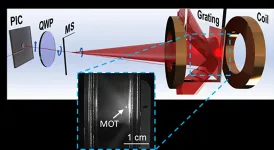(Press-News.org) Since the outbreak of SARS-CoV-2, it has quickly become apparent that children are extremely unlikely to suffer severe COVID-19 illness. Nevertheless, children have had to adjust to the new world of medical staff dressed in personal protective equipment (PPE) in the same way as all other patients. A new study from one of the UK's leading children's hospitals -Alder Hey Children's Hospital in Liverpool - shows that children are not scared by PPE, and can in fact feel reassured by it.
The study was conducted by Drs Charlotte Berwick, Jacinth Tan, Ijeoma Okonkwo and their colleagues at Alder Hey. It was performed in conjunction with the Procedure Induced Anxiety Network (PIANo-UK), led by Dr Richard Martin of Great Ormond Street Children's Hospital. This piece of work forms part of a larger multi-centre study evaluating the impact of PPE on children and young people undergoing anaesthesia.
The study results from Alder Hey were presented at the Winter Scientific Meeting of the Association of Anaesthetists, held online this year.
Anxiety before, during and after surgery in children is common and leads to complications including pain and delayed recovery. The requirement for staff to don PPE in the context of the coronavirus pandemic was thought to potentially contribute further to anxiety. The authors thus set out to investigate the true impact of PPE on fear and anxiety in children and young people.
The data collection period was from June 22 to July 5, 2020, and included children aged between 2 and 16 years old, using validated scales to score anxiety behaviour in the anaesthetic room.
A total of 63 children with a median age of 9 years were studied: 38/63 (60%) were boys and 25/63 (40%) were girls. Half of children (31/63: 49%) scored zero for anxiety indicating perfect induction of anaesthesia. There was no significant difference in anxiety when a sedative pre-medication was given, indicating that PPE did not impact the non-sedated children any more than those children who had been given a sedative to help manage their anxiety.
The authors explain: "At the start of the pandemic, there were real fears that we would have to separate hospitalised children from their parents, prior to theatre. It was thought that we would be using massive quantities of sedatives in all our patients to enable them to come to theatre safely and minimise the potential trauma from this forced separation."
In the day surgery cohort, 45 families were surveyed, and asked to use a numerical rating scale from 0-10 in answer to the question "How scary do you find staff wearing PPE". In another question, children and young people were asked to choose one or more words from a list of descriptors about how PPE made them feel. Patients could enter free text and/or select multiple descriptors including: I don't know, happy, safe, nervous, anxious, excited, giggly, scared, confident, worried, the same or sad.
Half of the responses (23/45 - 50%) included responses from the child or young person undergoing surgery. A total of 42/45 (93%) families had expected staff to be wearing PPE; 15/23 (65%) children reported it made them feel happy and 15/23 (65%) safe. None of the 23 (0%) chose anxious, nervous or scared as descriptors. Parents overestimated their child's fear of PPE (see graph in link below).
The authors conclude: "This study suggests that PPE does not contribute to anxiety in children and young people who need anaesthesia and surgery. Most patients experienced extremely low levels of anxiety at induction. PPE provided reassurance and increased a child's confidence in anaesthesia. Two thirds of children reported staff PPE made them feel safe and happy, and none reported being scared by PPE."
The authors say these results were a little surprising, saying: "We did expect some children to be scared because staff were wearing PPE. There is such a mix of different masks, hoods and gowns in use at our hospital, at the very least we had thought some patients would feel anxious about being cared for by a mixture of muffled-sounding staff resembling beekeepers, graffiti artists, blacksmiths and astronauts!"
"The finding that surprised us most were the overwhelmingly positive descriptors utilised by the children to describe how staff wearing PPE made them feel with most of them stating it made them feel happy and/or safe. Not a single child chose anxious, nervous or scared to describe how PPE made them feel. We were less surprised to find that parents overestimated their child's anxiety and fear. This is a more common protective response brought about by worry and concern."
While noting their study is limited by the absence of pre-COVID-19 data, they believe their work "highlights a probable psychological shift to a 'new normal' that warrants further study. PPE will likely remain commonplace in anaesthesia, understanding its impact will allow further improvements to the quality of the patient experience."
INFORMATION:
The sight of healthcare workers wearing personal protective equipment (PPE) to protect against transmission of SARS-CoV-2 is something the world has become accustomed to. However, a new study analysing the impact of PPE staff shows that the number and variety of issues they experience increases as their time in PPE without a break increases, ranging from tiredness and headaches in the first hour to nausea, vomiting and dizziness as they head towards four hours continuously in PPE.
The study is by Dr Tom Hutley, Dr Lynsey Woodward and Mr Joshua Berrington based at the University Hospitals Dorset NHS Foundation Trust, Bournemouth, UK, and was presented at the Winter Scientific ...
The results of a randomised clinical trial with the longest follow up to date show that metabolic surgery is more effective than medications and lifestyle interventions in the long-term control of severe type 2 diabetes.
The study, published today in The Lancet, also shows that over one-third of surgically-treated patients remained diabetes-free throughout the 10-year period of the trial. This demonstrates, in the context of the most rigorous type of clinical investigation, that a "cure" for type 2 diabetes can be achieved.
Researchers from King's College London and the Fondazione Policlinico Universitario Agostino Gemelli IRCCS, Rome, Italy report the 10-year outcomes of a trial that compared metabolic surgery with conventional medical and lifestyle interventions in patients ...
Food insecurity spiked among residents living in two predominantly African American neighborhoods during the first weeks of the coronavirus pandemic, far outpacing food insecurity observed among the general U.S. population during the same period, according to a new RAND Corporation study.
Following residents of two Pittsburgh low-income African American neighborhoods characterized as food deserts since 2011, the study found that the pandemic increased the number of people facing food insecurity by nearly 80%.
Similar to United States national trends, food insecurity among residents had been improving consistently since 2011. ...
When drought caused devastating crop losses in Malawi in 2015-2016, farmers in the southeastern African nation did not initially fear for the worst: the government had purchased insurance for such a calamity. But millions of farmers remained unpaid for months because the insurer's model failed to detect the extent of the losses, and a subsequent model audit moved slowly. Quicker payments would have greatly reduced the shockwaves that rippled across the landlocked country.
While the insurers fixed the issues resulting in that error, the incident remains a cautionary tale about the potential failures of agricultural ...
It's cool to be small. Scientists at the National Institute of Standards and Technology (NIST) have miniaturized the optical components required to cool atoms down to a few thousandths of a degree above absolute zero, the first step in employing them on microchips to drive a new generation of super-accurate atomic clocks, enable navigation without GPS, and simulate quantum systems.
Cooling atoms is equivalent to slowing them down, which makes them a lot easier to study. At room temperature, atoms whiz through the air at nearly the speed of sound, some 343 meters per second. The rapid, randomly moving atoms have only fleeting interactions ...
Black women have higher recurrence and mortality rates than non-Hispanic white women for certain types of breast cancer, according to a University of Illinois Chicago researcher's study published recently in JAMA Oncology.
Dr. Kent Hoskins, associate professor in the UIC College of Medicine's division of hematology/oncology, and co-leader of the Breast Cancer Research group in the University of Illinois Cancer Center, published the study, "Association of race/ethnicity and the 21-gene Recurrence Score with breast cancer-specific mortality among US women" in the Jan. 21 online issue.
Hoskins and the research team sought to discover if breast cancer-specific mortality among women with estrogen ...
Simon Fraser University researchers have found evidence that large ambush-predatory worms--some as long as two metres--roamed the ocean floor near Taiwan over 20 million years ago. The finding, published today in the journal Scientific Reports, is the result of reconstructing an unusual trace fossil that they identified as a burrow of these ancient worms.
According to the study's lead author, SFU Earth Sciences PhD student, Yu-Yen Pan, the trace fossil was found in a rocky area near coastal Taiwan. Trace fossils are part of a research field known as ichnology. "I was fascinated by this monster burrow at first glance," she says. "Compared to other trace fossils which are usually only a few tens of centimetres ...
A new collaborative study from researchers at the Geisel School of Medicine at Dartmouth and the University of Washington (UW) and published in the Proceedings of the National Academy of Sciences (PNAS), reveals unexpected insights into how skin exposure to ultraviolet (UV) light can worsen clinical symptoms in autoimmune diseases such as lupus.
Lupus, an autoimmune disease that can cause inflammation of the joints, skin, kidneys, blood cells, brain, heart and lungs, is caused when the immune system attacks its own tissue.
Previous research has established that in up to 80 percent of lupus patients, sunlight exposure can trigger both local skin inflammation and systemic flares, including kidney disease. But little has been understood about the underlying mechanisms that drive this process. ...
Doctors may be able to predict their patients' risks of fatal coronary heart disease more accurately by taking into account the number of adverse social factors affecting them, according to a new study led by researchers at Weill Cornell Medicine and NewYork-Presbyterian.
The researchers, whose findings appear Dec. 3 in Circulation, analyzed data from the Reasons for Geographic and Racial Differences in Stroke (REGARDS) Study that tracked cardiovascular-related health outcomes in more than 20,000 people for a decade. The new analysis showed that participants who had more adverse social determinants ...
The SARS-CoV-2 virus may enter and replicate in human cells by exploiting newly-identified sequences within cell receptors, according to work from two teams of scientists. The findings from both groups paint a more complete portrait of the various cellular processes that SARS-CoV-2 targets to not only enter cells, but to then multiply and spread. The results also hint that the sequences could potentially serve as targets for new therapies for patients with COVID-19, although validation in cells and animal models is needed. Scientists know that SARS-CoV-2 binds the ACE2 receptor on the surface of human cells, after which it enters the cell through a process known as endocytosis. Research has suggested that the virus may hijack or interfere with other processes such as cellular housekeeping ...


